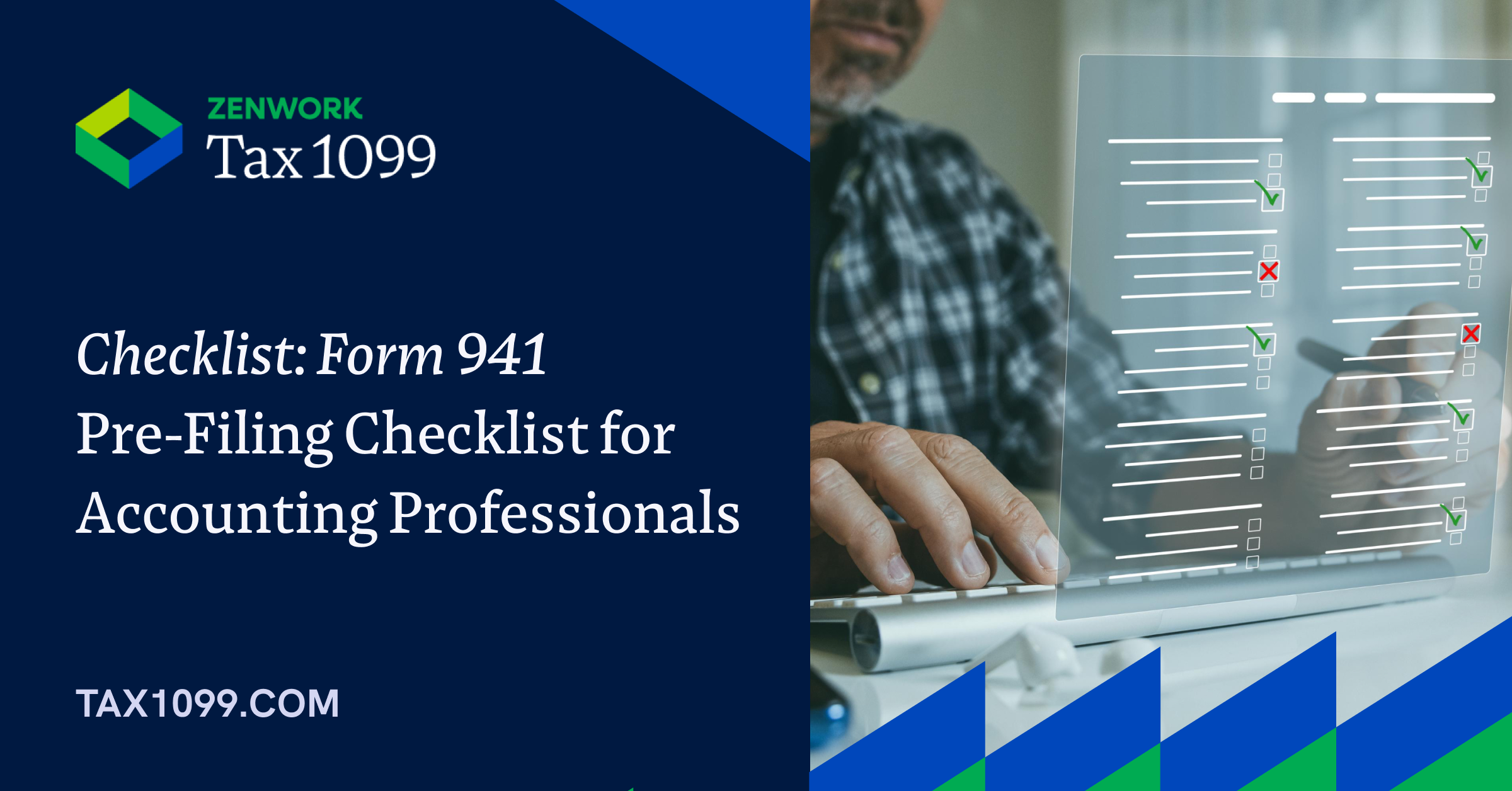Filing Form 941 may be routine, but it’s far from simple. It’s a cornerstone of payroll tax compliance, and as an accounting professional, your attention to detail keeps clients out of trouble with the IRS. In this blog, we have compiled a Form 941 pre-filing checklist you should follow to keep your clients in compliance with the IRS. But before we get into it, let’s break down what is reported on form 941, who files it, and important deadlines.
Who Must File Form 941?
Employers and businesses that pay wages subject to federal income tax withholding or social security and Medicare taxes must file Form 941 quarterly.
What is Reported on Form 941?
IRS Form 941 is used to report:
- Wages paid to employees
- Tips reported by employees
- Federal income taxes withheld
- Social Security and Medicare taxes
- Adjustments for sick pay, tips, group-term life insurance, etc.
What’s New? Use the March 2025 revision of Form 941 to report taxes for the first quarter of 2025; don’t use an earlier revision to report taxes for 2025. Related Article: IRS Form 941 Key Changes for 2025 TY
Deadlines for 2025 and Penalties
Form 941 must be filled out every quarter. Form 941 is due by the last day of the month following the end of the quarter.
| Quarter | Reporting Period | Due Date |
| Q1 | Jan 1- Mar 31 | April 30, 2025 |
| Q2 | Apr 1- Jun 30 | July 31, 2025 |
| Q3 | Jul 1- Sep 30 | Oct 31, 2025 |
| Q4 | Oct 1- Dec 31 | Jan 31, 2026 |
Note: Since Jan 31, 2026, falls on a Saturday, the due date will shift to the next working day i.e. February 02, 2026. Missing the 941 eFiling deadline can lead to a 5% penalty on the tax amount due. An additional charge of 5% for each month of missed reporting, up to a maximum of 25%, is imposed by the IRS.
Form 941 Pre-filing Checklist
Use this Form 941 pre-filing checklist to stay organized and make sure your client’s 941 forms are correctly filed quarter after quarter.
Verify Business Information (Name, Address, & EIN)
Before reporting the numbers, confirm that the client’s identifying information, including name, address, and EIN, is correct and consistent with IRS records. Your client’s business should have only one unique nine-digit Employer identification number (EIN). An EIN is a number that is used throughout the life of the company on all tax returns, payments, and reports. If they don’t have an EIN, they will need to apply for it by going to IRS.gov/EIN or by mailing Form SS-4 to the IRS.
Calculate the Taxable Social Security & Medicare wages
Your client’s taxable Social Security and Medicare wages must be accurately calculated and reported on lines 5a to 5e of Form 941. Social Security tax applies to wages up to the annual wage base limit ($168,600 in 2025). The employee portion is 6.2%, and your client must match this amount. To calculate it, you multiply the taxable Social Security wages by 12.4%. Medicare tax applies to all wages without a cap. The standard rate is 1.45% for both employees and employers. The overall FICA liability for the quarter is then calculated by adding together the Social Security and Medicare taxes.
Adjustments to Tax Liability
You will need to account for any necessary adjustments, including rounding errors (fractions of cents), sick pay issued by third-party providers (such as insurance companies), and the value of group-term life insurance coverage over $50,000. The nature of the adjustments may increase or decrease your client’s tax liability. Be sure to apply these changes before factoring in any credits so the IRS has an accurate picture of what’s actually owed.
Apply for Available Tax Credits
Form 941 allows certain tax credits, such as the Work Opportunity Tax Credit (WOTC) or the Employee Retention Credit (ERC) to be claimed by reporting them in line 11 for general business credits and line 13 for specific employment tax credits. If your client is claiming any valid credits, such as the WOTC and the ERC, it may require additional reporting on Schedule B of Form 941. It’s important to distinguish between nonrefundable credits (which directly reduce the amount owed) and refundable credits, which could lead to a refund or a carryover to the next quarter.
Report Tax Deposits and Balances
Form 941 requires information about the total tax deposits made during the quarter. Most businesses make these deposits through EFTPS, following either a monthly or semiweekly deposit schedule. On Line 13, you’ll need to report the amount already deposited, and on Line 12, the total tax due. If it is overpaid, you can request a refund or apply the surplus to the next quarter. If the deposits fall short, the balance due must be paid when filing.
Determine Deposit Schedule
Identify your client’s deposit schedule. It can either be monthly or semiweekly based on their tax liability. If your client is a monthly depositor, you’ll need to enter their tax liability for each of the three months in the quarter using the boxes labeled Month 1, Month 2, and Month 3. The sum of these amounts must match the total tax liability reported on Line 12 in Part 1 of the form. Clients with a more significant payroll tax liability (more than $50,000) are considered semiweekly depositors. In this case, you must complete and attach Schedule B of Form 941. This schedule requires a daily breakdown of tax liability for each day of the quarter.
Reconcile Form 941 with Year-End Filings
It’s essential to make sure the Form 941 filings match the year-end Form W-3 and the accompanying W-2s. The IRS and Social Security Administration cross-check these totals so any mismatches could trigger a notice or delay. To avoid headaches during the W-2 season, confirm that wages, tips, and tax amounts on all four Form 941s add up to the totals reported on Form W-2 (Boxes 1, 3, 5) and Form W-3. Also, double-check that Social Security and Medicare wages and taxes on the 941s match W-2 Box 3–6 amounts. For employers and businesses subject to FUTA, Form 940 should reflect consistent wage figures with the 941s for taxable employees. And if your client is a multistate employer, ensure that state wage reports are in sync too.
Get authorized signatory details
Always make sure all required information is complete, including the authorized signatory details. The person signing must be authorized based on the business structure. For sole proprietors, the owner signs the return. For corporations (including LLCs treated as corporations), an officer such as the president or vice president can sign. Partnerships or LLCs treated as partnerships must have a responsible partner or member with authority if it’s a single-member LLC disregarded for federal tax purposes, the owner or an authorized officer signs. For a trust or estate, the fiduciary is responsible for signing. If the client is using a third-party designee (like a payroll provider or accounting firm), ensure their authorization is indicated correctly. Also, double-check that the total wages paid, number of employees, and any adjustments or applicable tax credits are clearly filled in and accurate.
File on time with Tax1099
Tax1099 is an IRS-approved 941 eFiling provider that offers a reliable and efficient platform to simplify your tax filing process. Our platform gives accounting professionals the flexibility and efficiency needed to manage Form 941 filing confidently.
- Automatic form generation from your payroll system
- Real-time status updates and notifications for complete visibility
- Bulk TIN matching to verify up to 10,000 records instantly and flag mismatches
- Workflow management allows you to assign tasks like data entry and form reviews.



